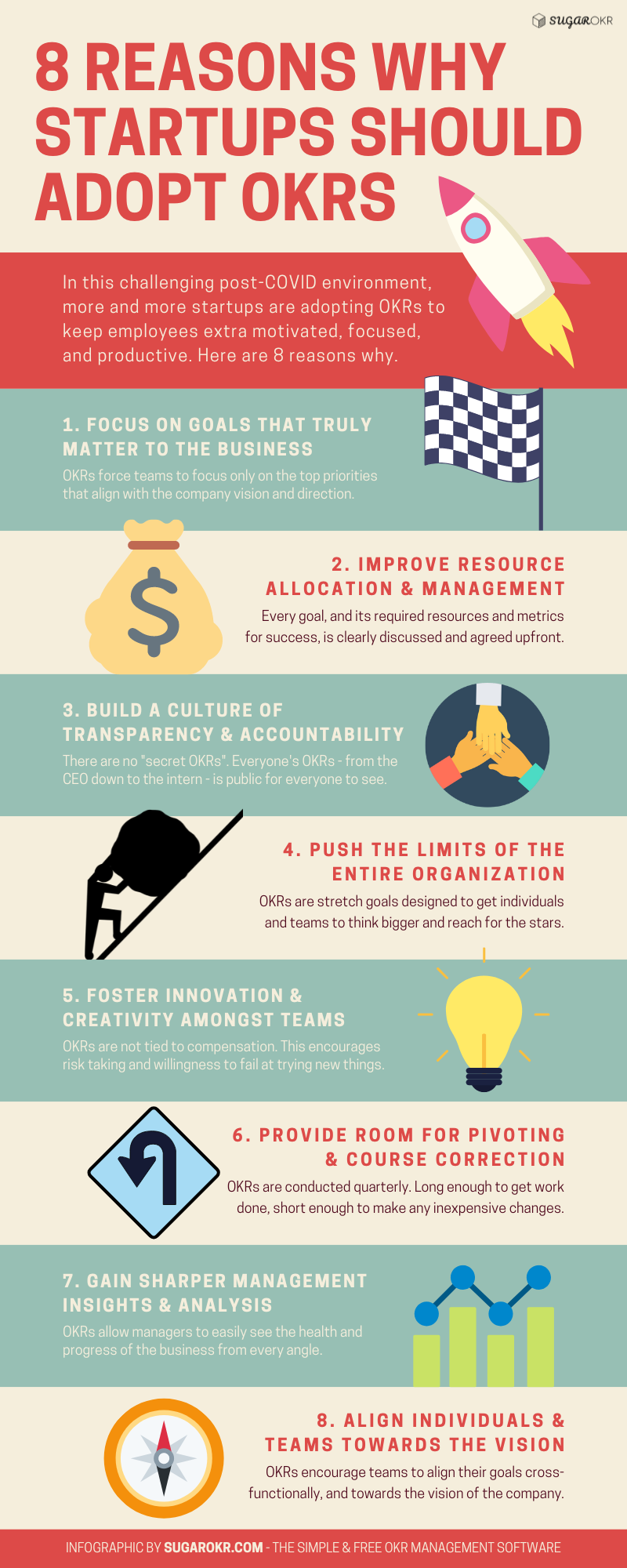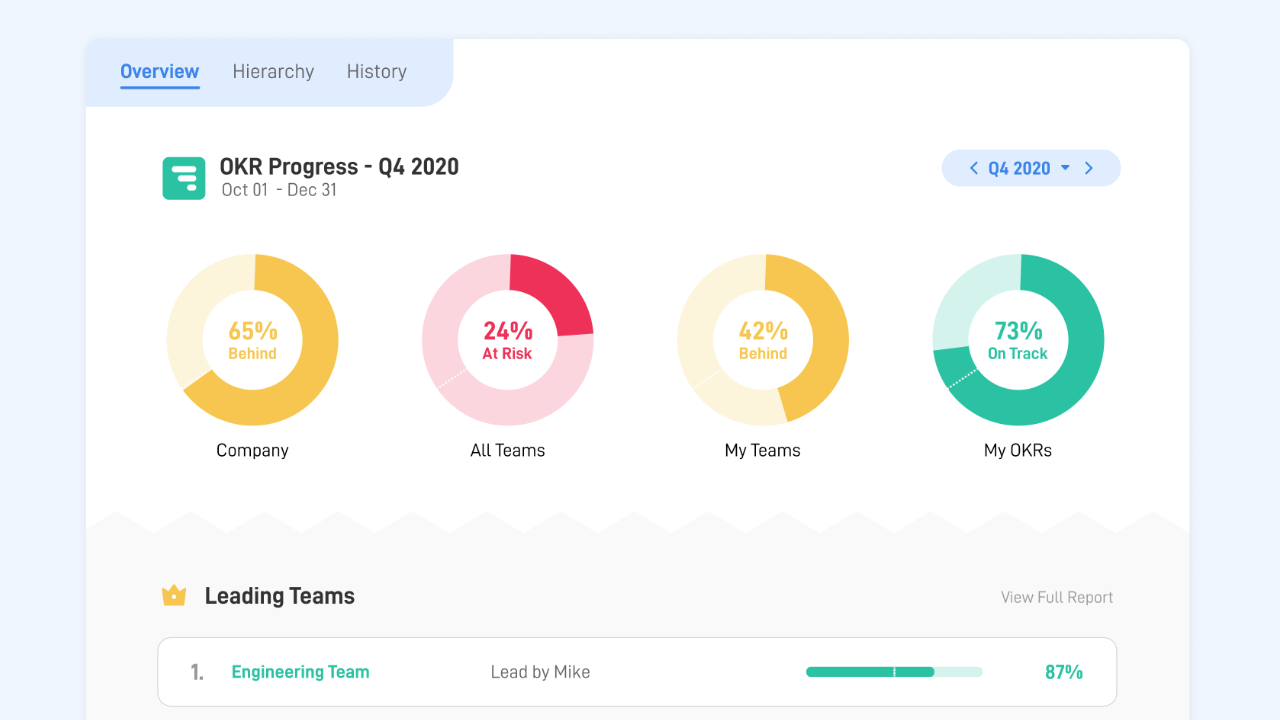By now, we have all experienced how COVID had changed the way we work and conduct business.
All over the world, companies tightened budgets, scaled back on resources, repurposed roles, and optimized for a remote workforce. Till today, startups – without the large war chests that large organizations have – are constantly still at the risk of being thrown out of the ring altogether.
In this article, we will examine why startups worldwide have been increasingly adopting startup OKRs (Objectives and Key Results) to keep employees extra motivated, focused, and productive; especially in this post-COVID environment.
Note that while OKRs can be easily adopted by any company of any size, a sweet spot does somewhat lie in startups within the 20-100 employee range.
These are typically early-to-mid stage startups that already have a certain level of product market fit and traction (adoption/revenue). They have big concrete plans and a strong desire to grow aggressively. Small (or young) startups (i.e. fewer than 20 employees) are typically still in early discovery mode without concrete execution plans, while big startups (more than 100 employees) may find implementing new frameworks and methodologies difficult and daunting. These 2 scenarios make implementing startup OKRs a little more challenging (but again, not impossible).
That being said, there are of course many exceptions to this. An 8 man team can have as much traction and growth as an 80 man team, and a 200 man startup can still be struggling to find product market fit. Don’t be fixated on the numbers.
So if your early/mid stage startup lies in this sweet spot of 20-100 employees, and has yet to implement the OKR goal setting framework, here are 8 reasons why you absolutely should implement startup OKRs, especially in this new norm we live in.
#1 Focus on goals that truly matter to the business
Too often, everyone at work is busy just being busy. Teams are constantly working on projects and campaigns that don’t align to the larger vision, and individuals are wasting time executing tasks that end up moving the wrong dial. This is particularly prevalent in startups where experiments are conducted more frequently, till a point people unwittingly start veering off course.
The OKR framework forces teams to think about the big rocks (and only the big rocks) of the business. Every quarter, teams get quarterly guidance (top-level goals) from the CEO/management team, and ask themselves the following questions when planning their objectives:
“What are the top goals we absolutely need to work towards this quarter that truly matter to the business?”
“What are the key drivers metrics that will help up hit those goals?”
Once these goals are agreed on (cross-functionally and by the CEO/management team), everyone puts their blinders on, and focuses 100% on those goals. Everything else from then on is a distraction that isn’t entertained.
Note: As always, exercise common sense. If an objective suddenly isn’t working out or doesn’t make sense, don’t flog a dead horse. Do a quick retro, can it, and move on.
#2 Improve resource allocation & management
During the quarterly OKR planning process, it suddenly becomes easy to see how effectively your company’s resources are being allocated. This is extremely important for startups that are by nature, resource-strapped.
Before this, you may not have realized that 10-20% of your employees (or budget) are being put to poor use. “Why are we working on this project again?” and “Why are we spending this much money on this campaign again?” are common questions raised by frustrated managers late into the quarter.
OKRs on the other hand make things extremely clear right from the start.
Every goal, and its required resources and metrics for success, is clearly discussed and agreed upon upfront. If a goal doesn’t align to the larger vision or doesn’t provide any meaningful ROI, it wouldn’t make the cut to begin with. This ensures all resources are put to the best use, each and every quarter. There are no more confusions, and managers can confidently justify (at any point in time) why any decision was made.
#3 Build a culture of transparency & accountability
The bigger the startup (employee count), the higher the propensity for people to be unaware of what their colleagues or other teams are working on. This even extends to managers and their direct reports (surprising yet true).
Teams and individuals become siloed, working “silently” in their own world. When things don’t work out, people start to point fingers at each other, without really knowing who (or which team) should be held accountable.
Sound familiar?
In the OKR framework, there are no “secret OKRs”. Everyone’s startup OKRs – from the CEO down to the intern – is made public for everyone to see. This level of transparency not only allows everyone to know what everyone is doing, but more importantly, why they are doing what they are doing. Instead of, “I’m not sure what the Marketing team is working on this quarter.“, it becomes, “I know the top objective of the Marketing team this quarter is to increase our brand awareness in the UK, because this is part of our expansion plans. They intend to achieve this via these 5 tactics…“.
At the end of every quarter, anything that fell through can easily tied back to the team/person responsible. Everyone is now held accountable to what they signed up for and own.
#4 Push the limits of the entire organization
In a fast growing startup, the only way to achieve hyper-growth is for the organization to set ambitious goals. This seems obvious, yet how many people truly have ambitious goals? More often than not, managers set “reasonable” targets so employees won’t feel demoralized or unfairly treated. This approach is dangerous because everyone ends up doing just enough to keep their jobs, or get their commissions/bonuses.
One of the unique traits about the OKR framework is that it discourages teams/individuals to hit 100% (OKR score of 1.0) of every target/goal. Rather, somewhere in the 70-80% range is recommended. Why is that?
Think about it, if Lisa is consistently hitting 100%, it may signal that she is a top performer; but it also signals she is capable of accomplishing way more. Unfortunately, because the bar is set low, Lisa’s full contribution is never extracted (and the company loses out on that).
Startup OKRs push managers to set ambitious “stretch” goals. These goals are certainly bolder and more difficult, but not entirely unachievable. Suddenly the bar is raised and everyone is reaching for the stars. Closing in on these goals collectively (and consistently) quarter over quarter then pushes the startup towards hyper-growth.
Note: While the above mentioned stretch goals are “aspirational OKRs”, there is another type called “committed OKRs” that do actually require owners to hit 100% (OKR score of 1.0). Read more about aspirational vs committed OKRs here.
#5 Foster innovation & creativity amongst teams
Setting stretch goals in the OKR framework may scare teams and employees initially. Who on earth wants to have to work harder towards more difficult goals?
OKRs are not tied to employee compensation/remuneration (and managers need to communicate this) and that’s the true beauty of it. This system also has a wonderful side effect: people start to take more risks, think less about themselves, and more for the company. (No one is going to be fired for not hitting 100%.) This mindset creates a culture of innovation and creativity (a valuable startup culture), motivating teams to come up with interesting new ways to hit their goals.
It goes from “We just need to close 10 deals a quarter and we should be fine.“, to “What can we do so that we end up closing 100 deals a quarter?“.
While the latter mindset may not actually result in 100 deals closed a quarter, you can bet your bottom dollar that the number will be way higher than 10.
Note: There should obviously still be baseline KPIs for everyone’s compensation/remuneration to be measured on (especially those in Sales). Think of OKRs as an added layer over that. Managers need to communicate this and build a culture for employees to really go all out and not be afraid to fail while trying. While not officially tied to compensation/remuneration, leaders also see OKRs as a good way to separate the superstars from the pack, and base bonuses/promotions on.
#6 Provide room for pivoting and course correction
Let’s be real. Startups rarely get things right the first time. Lots of assumptions are made and experiments conducted to learn what works and what doesn’t. A proper time frame based system is crucial to getting things organized and keeping things in check.
OKRs are designed to be conducted on a quarterly basis (ideally). Quarters work well because they are long enough periods of time for projects and campaign to run their course meaningfully, yet short enough so that should anything go wrong, teams can pivot their strategy and course correct without too much time and resources wasted.
The OKR framework also recommends teams work on 3-5 objectives (each with 3-5 key results) per quarter. This acts as a hedge should any objective fall through. A common mistake startups make is putting all their resources on a single objective. This is dangerous as failure to deliver is not only extremely costly but is also demoralizing for everyone.
As previously mentioned, the OKR framework forces an organization to think of the top few bets every quarter. If one (or some) fail, at least the company is still moving forward.
Note: This is not to say you should ditch other approaches with shorter time frames. For example, scrum teams can still use weekly sprints to work towards their OKRs. What OKRs do is tell everyone what the output of all the weekly sprints are supposed to amount to, and how that’s relevant and aligned to the larger goals of the company.
#7 Gain sharper management insights & analysis
If you’re a CEO or part of the management team, you’re probably not always clued in to things happening on the ground. Very often, you’ll just rely on what your managers tell you, and the “data” they present to you. That may be helpful to some degree but what if you could see it all for yourself?
As elaborated in point #2 and #3, the OKR framework is designed for all the cards to be put on the table.
The resources required for every single objective is communicated and justified upfront, and there is a clear path (via the objective’s key results) to success. Weekly syncs are conducted religiously to monitor the progress of every single OKR, which in turn allows the CEO/management team to ascertain the true “health” of the business at any given point in time. Startup OKRs that are at risk are quickly surfaced, and proper analysis of the situation is made so that appropriate action can be taken.
This results in you always having a clear idea of: (1) what resources are being used, (2) where they are being allocated, (3) what is working and what isn’t, and (4) why that is so. No more black boxes.
#8 Align individuals & teams towards the vision
One of the biggest (and most talked about) benefit that OKRs have is that it aligns everyone towards the vision of the company. This is particularly helpful in the startup world, where pivots and changes in business direction happen more frequently, and employees unwittingly lose track of where the company should be heading.
Here’s a hypothetical scenario:
Sales Team: “Our objective in Q3 is to close 10 new enterprise accounts in California.”
Marketing Team: “Our objective in Q3 is to increase online web conversions to get more leads for the Sales Team.”
Sales Team: “But most of the web leads originate from Asia. It’s not helping us hit our goal.”
Marketing Team: “Why the heck are you focusing on California in the first place?”
CEO: “Hey guys… by the way, our company objective in Q3 is to grow our business in Russia.”
Part of the OKR planning process is for teams to communicate their plans cross-functionally and see how their startup OKRs can be better aligned with each other. It starts with the CEO/management team owning the vision of the entire company and setting company-level OKRs for the quarter. Teams then use that as a guidepost to create their OKRs that align to that. Sometimes, Team A’s OKR will impact Team B’s OKR, which impacts Team C’s OKR, which ultimately impacts the CEO’s company-level OKR. In such a scenario, everyone in Team A can see how the work they’re doing is actually helping the CEO hit his/her top-level OKR for the quarter.
The result is highly motivated individuals and aligned teams, who know why they are doing what they do, every single day.
Note: The most crucial role here is the CEO / management team. They need to first be very clear on the the vision / direction of the company (for the year and broken down into quarters). After that, they need to communicate this clearly to the entire company. Avoid just communicating to managers as miscommunication and the broken telephone effect may occur. Write a narrative, memo, slide deck, whatever, and share it with the entire company. Everyone should police everyone when OKRs are being planned and ask, “Is this even relevant to our company direction this quarter?“.
Summary: Why adopt startups OKRs? [Infographic]
Early/mid stage startups are most vulnerable in this unforgiving post-COVID world. They generally don’t have a ton of cash and they certainly don’t have a ton of time. While the OKR framework is one of the most widely adopted goal setting methodologies in the world today, it’s not a silver bullet and it’s also not for everyone.
If you feel the 8 benefits of OKRs presented here are something your startup could really use, and your company is willing to commit to change, then dig deeper. You could be on to something game changing.
Click image to expand
SugarOKR is a beautifully simple and easy to use free OKR management tool that helps teams unlock the full potential of OKRs, while staying focused and motivated. To find out how your startup can win with OKRs, visit us at sugarokr.com.






